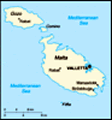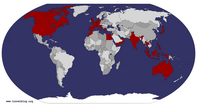Advertisement
Published: August 31st 2017
Today we’ve booked to go to the Hypogeum of Hal-Saflieni archaeological site, a few kilometres south of Valletta. We made the booking several months ago to be sure we could get in, which apparently was far from guaranteed; it seems they only allow a maximum of eighty people in each day in strictly controlled groups of no more than ten.
It seems to be a bit cooler today, with some clouds and a gentle breeze. Our taxi driver says that it's been the hottest summer he can remember - some days of 45 degrees outside, which usually translates to 50 in his cabin. He says that days like that are very bad for business, as even the tourists don't go outside. There's apparently full employment in Malta and they need to import workers from other parts of Europe to do some of the less desirable jobs, which leaves me wondering why our cabbie's still doing what he's doing.
We're dropped in a street in the middle of suburbia, and pointed to the Hypogeum's entrance. We're a bit worried that perhaps we've been brought to the wrong place; we were expecting the site to out in the middle of a
paddock somewhere. It seems we were right to book early - a sign at the entrance tells us that the next available entry tickets are for mid-October. We follow strict instructions to deposit all our bags, cameras and mobile phones in a locker, and our group's then shown into two ante rooms to watch an audio-visual presentation. The site's all underground and is accessed via some steep steps. We're warned that it's a bit slippery down there, and that some of the openings through the gaps in the rocks are a bit tight. One of the members of our group is a tall and very elderly Frenchman, who seems to only be able to walk with the help of a stick. It feels almost inevitable that he'll bump his head and/or slip down the steps at some stage, and I guess I'll then be called on to help cart him back up to the surface. I wonder if they'll give me a discount.
The Hypogeum's a burial site on three levels and is believed to be somewhere between five and six thousand years old. It's thought to have been in use until around 2500 BC, and some 7,000 skeletons
in various states of decay have been found here. No one's quite sure what happened to the civilisation that built it. It was discovered by accident in 1902 during construction of some water storage cisterns for a new housing development. Extensive measures have been put in place in recent years to protect it from damage from carbon dioxide, light and water. The humidity and light levels are carefully controlled; we enter through a glass door, and once this seals behind us a second door opens to let us through to the top of the stairs. Dim lights come on automatically as we go into various sections of the site, and then turn off again as soon as we leave. Apparently algal growth was a real problem here at one stage, and was responsible for the fading of some of the characteristic red ochre symbols on the walls. The whole place is spectacular. The chambers have been carved out of solid rock, but in a way that makes it look like they've used individual carved slabs. This makes the whole thing look very similar in style to other prehistoric temples we've seen on the surface here in Malta.
Next cab
off the rank are the Tarxien Temples, another archaeological site which we're told is only a couple of hundred metre's walk from the Hypogeum. This is good to know, but it would probably also have been good to know in which direction. We've noticed that just about everyone here seems to be friendly and eager to help. As we go to cross a street in front of a truck, it screeches to a halt next to us. If this happened back home we'd get a torrent of abuse from the driver, but no, he winds down his window and asks us very politely if he can help us, as he thought we looked a bit lost.
Unlike the Hypogeum, the Tarxien site is entirely outdoors and is protected from the elements by a large tent like structure. The Temples date from around 3100 BC, and were discovered in 1914 when a farmer kept banging into large pieces of rock while he was ploughing, which presumably can't have done his plough much good. The site's massive. It's again in the middle of suburbia, and it looks a bit incongruous to see people hanging their clothes out on balconies only a
few metres away from it. We pass the apparently famous "fat lady" statue, which is the lower half of a very well nourished body with some feet attached to the bottom. Apparently it could be either a man or a woman. If this was back in Australia the local feminists would certainly have had something to say about the name by now.
We catch the bus to our next destination, Ghar Dalam. Louis told us to come here, but now we can't remember why. We're wondering how the next conversation with a friendly local might go - "excuse me, could you please tell us how to get to .... um.... well we're not quite sure....?" Louis mentioned something yesterday about a state-of-the-art dementia hospital on the island, and I think we might be in danger of becoming its newest residents.
Luckily there's a sign right across the road from the bus stop pointing us to the Ghar Dalam archaeological site. We're out in the paddocks now, so it seems that this site's a bit more conventionally located. I think that we might be quite the archaeological experts after visiting three sites in one morning. On reflection maybe not;
in reality we're still just tourists who visit things we're told to visit, even if in some cases we've got no idea what they are.
The Ghar Dalam site is a cave where a large number of animal bones and other relics from the last ice age have been discovered, including dwarf elephants, hippopotamuses, deer and bears. We read that there were hippopotamuses in England during the last ice age. I wonder why there aren't any there now; if our experience is anything to go by the climate's still the same. It seems that they've found evidence here of the earliest human settlement on Malta some 7,400 years ago. We walk down a hill to the cave entrance, and then along a boardwalk fifty or so metres into the hillside. A sign on a barrier then tells us that we can't go any further because we might disturb a colony of rare Maltese lice. I thought that lice only lived in hair, and I don't think there's too much of that down here.
We catch the bus back to Valletta. We're pleased to be feeling like we're travelling like locals. This feeling lasts until we find that we're
the only two people left on the bus, and the driver tells us that we've missed the last stop and shouldn't still be here. Luckily he's feeling sorry for us and lets us off before heading back to the depot.
We have dinner with Louis and Lily at a restaurant on the waterfront at Marsaxlokk. The owner's Sicilian, and serves us some Sicilian wine. We take a close look at the bottle. It seems that it's made by the Corleone family. My blood turns to ice. This must be a message. We've clearly done something to upset someone important while we were in Sicily, probably while we were driving, and now they've tracked us down to extract their revenge. We tell the owner that the wine's very good, leave a large tip, and sneak away quietly. I don't think we've been followed.
Louis is keen to take us to a feast celebration at the large village of Zurrieq near the Blue Grotto. On the way we pass through another village which Louis says is called Asher, at least that's what it sounded like. I ask him how it's spelt, and he responds Ghaxaq. I think that after several
months of guesses I probably still wouldn't have come up with that particular combination of letters.
The whole of Zurrieq is spectacularly decorated, especially the church, and the party's in full swing. Louis tells us that tonight's only one of the many warm ups to the real deal which will be on Sunday. If what's on display tonight's anything to go by I think everyone should be fairly warm by then. The square's packed, and every possible vantage point's occupied, including children perched on their parent's shoulders. Everyone's singing passionately. Red seems to be very much the colour of choice; just about everyone's decked in a red shirt and waving a red flag, and at midnight hundreds of red balloons are released over the crowd triggering a mad scramble to burst them all. Apparently there's fierce competition in the village between two opposing church clubs, the red club and the blue club, whose feasts are held at different times of the year. Louis says that people from the blue club would rather stick pins in their eyes than be seen here tonight, and it seems the feeling's mutual. We leave as the fireworks kick off (that's lights in the sky, not fisticuffs) and we watch the display from the street near Louis' car.
Advertisement
Tot: 0.085s; Tpl: 0.012s; cc: 13; qc: 30; dbt: 0.0552s; 1; m:domysql w:travelblog (10.17.0.13); sld: 1;
; mem: 1.1mb










